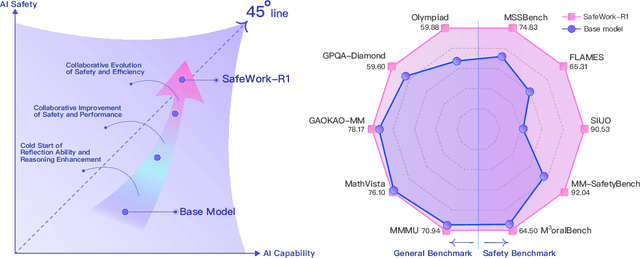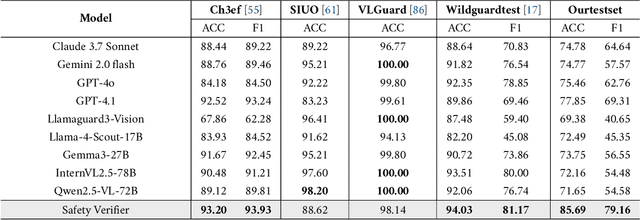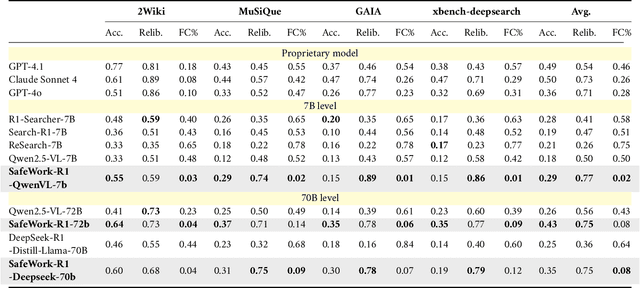Sirui Chen
NIRVANA: Structured pruning reimagined for large language models compression
Sep 17, 2025Abstract:Structured pruning of large language models (LLMs) offers substantial efficiency improvements by removing entire hidden units, yet current approaches often suffer from significant performance degradation, particularly in zero-shot settings, and necessitate costly recovery techniques such as supervised fine-tuning (SFT) or adapter insertion. To address these critical shortcomings, we introduce NIRVANA, a novel pruning method explicitly designed to balance immediate zero-shot accuracy preservation with robust fine-tuning capability. Leveraging a first-order saliency criterion derived from the Neural Tangent Kernel under Adam optimization dynamics, NIRVANA provides a theoretically grounded pruning strategy that respects essential model training behaviors. To further address the unique challenges posed by structured pruning, NIRVANA incorporates an adaptive sparsity allocation mechanism across layers and modules (attention vs. MLP), which adjusts pruning intensity between modules in a globally balanced manner. Additionally, to mitigate the high sensitivity of pruning decisions to calibration data quality, we propose a simple yet effective KL divergence-based calibration data selection strategy, ensuring more reliable and task-agnostic pruning outcomes. Comprehensive experiments conducted on Llama3, Qwen, and T5 models demonstrate that NIRVANA outperforms existing structured pruning methods under equivalent sparsity constraints, providing a theoretically sound and practical approach to LLM compression. The code is available at https://github.com/iDEA-iSAIL-Lab-UIUC/NIRVANA.
Arrows of Math Reasoning Data Synthesis for Large Language Models: Diversity, Complexity and Correctness
Aug 26, 2025Abstract:Enhancing the mathematical reasoning of large language models (LLMs) demands high-quality training data, yet conventional methods face critical challenges in scalability, cost, and data reliability. To address these limitations, we propose a novel program-assisted synthesis framework that systematically generates a high-quality mathematical corpus with guaranteed diversity, complexity, and correctness. This framework integrates mathematical knowledge systems and domain-specific tools to create executable programs. These programs are then translated into natural language problem-solution pairs and vetted by a bilateral validation mechanism that verifies solution correctness against program outputs and ensures program-problem consistency. We have generated 12.3 million such problem-solving triples. Experiments demonstrate that models fine-tuned on our data significantly improve their inference capabilities, achieving state-of-the-art performance on several benchmark datasets and showcasing the effectiveness of our synthesis approach.
SafeWork-R1: Coevolving Safety and Intelligence under the AI-45$^{\circ}$ Law
Jul 24, 2025



Abstract:We introduce SafeWork-R1, a cutting-edge multimodal reasoning model that demonstrates the coevolution of capabilities and safety. It is developed by our proposed SafeLadder framework, which incorporates large-scale, progressive, safety-oriented reinforcement learning post-training, supported by a suite of multi-principled verifiers. Unlike previous alignment methods such as RLHF that simply learn human preferences, SafeLadder enables SafeWork-R1 to develop intrinsic safety reasoning and self-reflection abilities, giving rise to safety `aha' moments. Notably, SafeWork-R1 achieves an average improvement of $46.54\%$ over its base model Qwen2.5-VL-72B on safety-related benchmarks without compromising general capabilities, and delivers state-of-the-art safety performance compared to leading proprietary models such as GPT-4.1 and Claude Opus 4. To further bolster its reliability, we implement two distinct inference-time intervention methods and a deliberative search mechanism, enforcing step-level verification. Finally, we further develop SafeWork-R1-InternVL3-78B, SafeWork-R1-DeepSeek-70B, and SafeWork-R1-Qwen2.5VL-7B. All resulting models demonstrate that safety and capability can co-evolve synergistically, highlighting the generalizability of our framework in building robust, reliable, and trustworthy general-purpose AI.
Synthesis by Design: Controlled Data Generation via Structural Guidance
Jun 09, 2025Abstract:Mathematical reasoning remains challenging for LLMs due to complex logic and the need for precise computation. Existing methods enhance LLM reasoning by synthesizing datasets through problem rephrasing, but face issues with generation quality and problem complexity. To address this, we propose to extract structural information with generated problem-solving code from mathematical reasoning and guide data generation with structured solutions. Applied to MATH and GSM8K, our approach produces 39K problems with labeled intermediate steps and a 6.1K-problem benchmark of higher difficulty. Results on our benchmark show that model performance declines as reasoning length increases. Additionally, we conducted fine-tuning experiments using the proposed training data on a range of LLMs, and the results validate the effectiveness of our dataset. We hope the proposed method and dataset will contribute to future research in enhancing LLM reasoning capabilities.
OpenGT: A Comprehensive Benchmark For Graph Transformers
Jun 05, 2025Abstract:Graph Transformers (GTs) have recently demonstrated remarkable performance across diverse domains. By leveraging attention mechanisms, GTs are capable of modeling long-range dependencies and complex structural relationships beyond local neighborhoods. However, their applicable scenarios are still underexplored, this highlights the need to identify when and why they excel. Furthermore, unlike GNNs, which predominantly rely on message-passing mechanisms, GTs exhibit a diverse design space in areas such as positional encoding, attention mechanisms, and graph-specific adaptations. Yet, it remains unclear which of these design choices are truly effective and under what conditions. As a result, the community currently lacks a comprehensive benchmark and library to promote a deeper understanding and further development of GTs. To address this gap, this paper introduces OpenGT, a comprehensive benchmark for Graph Transformers. OpenGT enables fair comparisons and multidimensional analysis by establishing standardized experimental settings and incorporating a broad selection of state-of-the-art GNNs and GTs. Our benchmark evaluates GTs from multiple perspectives, encompassing diverse tasks and datasets with varying properties. Through extensive experiments, our benchmark has uncovered several critical insights, including the difficulty of transferring models across task levels, the limitations of local attention, the efficiency trade-offs in several models, the application scenarios of specific positional encodings, and the preprocessing overhead of some positional encodings. We aspire for this work to establish a foundation for future graph transformer research emphasizing fairness, reproducibility, and generalizability. We have developed an easy-to-use library OpenGT for training and evaluating existing GTs. The benchmark code is available at https://github.com/eaglelab-zju/OpenGT.
PreGenie: An Agentic Framework for High-quality Visual Presentation Generation
May 27, 2025Abstract:Visual presentations are vital for effective communication. Early attempts to automate their creation using deep learning often faced issues such as poorly organized layouts, inaccurate text summarization, and a lack of image understanding, leading to mismatched visuals and text. These limitations restrict their application in formal contexts like business and scientific research. To address these challenges, we propose PreGenie, an agentic and modular framework powered by multimodal large language models (MLLMs) for generating high-quality visual presentations. PreGenie is built on the Slidev presentation framework, where slides are rendered from Markdown code. It operates in two stages: (1) Analysis and Initial Generation, which summarizes multimodal input and generates initial code, and (2) Review and Re-generation, which iteratively reviews intermediate code and rendered slides to produce final, high-quality presentations. Each stage leverages multiple MLLMs that collaborate and share information. Comprehensive experiments demonstrate that PreGenie excels in multimodal understanding, outperforming existing models in both aesthetics and content consistency, while aligning more closely with human design preferences.
Exploring Consciousness in LLMs: A Systematic Survey of Theories, Implementations, and Frontier Risks
May 26, 2025Abstract:Consciousness stands as one of the most profound and distinguishing features of the human mind, fundamentally shaping our understanding of existence and agency. As large language models (LLMs) develop at an unprecedented pace, questions concerning intelligence and consciousness have become increasingly significant. However, discourse on LLM consciousness remains largely unexplored territory. In this paper, we first clarify frequently conflated terminologies (e.g., LLM consciousness and LLM awareness). Then, we systematically organize and synthesize existing research on LLM consciousness from both theoretical and empirical perspectives. Furthermore, we highlight potential frontier risks that conscious LLMs might introduce. Finally, we discuss current challenges and outline future directions in this emerging field. The references discussed in this paper are organized at https://github.com/OpenCausaLab/Awesome-LLM-Consciousness.
GeoDEx: A Unified Geometric Framework for Tactile Dexterous and Extrinsic Manipulation under Force Uncertainty
May 01, 2025Abstract:Sense of touch that allows robots to detect contact and measure interaction forces enables them to perform challenging tasks such as grasping fragile objects or using tools. Tactile sensors in theory can equip the robots with such capabilities. However, accuracy of the measured forces is not on a par with those of the force sensors due to the potential calibration challenges and noise. This has limited the values these sensors can offer in manipulation applications that require force control. In this paper, we introduce GeoDEx, a unified estimation, planning, and control framework using geometric primitives such as plane, cone and ellipsoid, which enables dexterous as well as extrinsic manipulation in the presence of uncertain force readings. Through various experimental results, we show that while relying on direct inaccurate and noisy force readings from tactile sensors results in unstable or failed manipulation, our method enables successful grasping and extrinsic manipulation of different objects. Additionally, compared to directly running optimization using SOCP (Second Order Cone Programming), planning and force estimation using our framework achieves a 14x speed-up.
ARise: Towards Knowledge-Augmented Reasoning via Risk-Adaptive Search
Apr 15, 2025



Abstract:Large language models (LLMs) have demonstrated impressive capabilities and are receiving increasing attention to enhance their reasoning through scaling test--time compute. However, their application in open--ended, knowledge--intensive, complex reasoning scenarios is still limited. Reasoning--oriented methods struggle to generalize to open--ended scenarios due to implicit assumptions of complete world knowledge. Meanwhile, knowledge--augmented reasoning (KAR) methods fail to address two core challenges: 1) error propagation, where errors in early steps cascade through the chain, and 2) verification bottleneck, where the explore--exploit tradeoff arises in multi--branch decision processes. To overcome these limitations, we introduce ARise, a novel framework that integrates risk assessment of intermediate reasoning states with dynamic retrieval--augmented generation (RAG) within a Monte Carlo tree search paradigm. This approach enables effective construction and optimization of reasoning plans across multiple maintained hypothesis branches. Experimental results show that ARise significantly outperforms the state--of--the--art KAR methods by up to 23.10%, and the latest RAG-equipped large reasoning models by up to 25.37%.
GTR: Graph-Table-RAG for Cross-Table Question Answering
Apr 03, 2025Abstract:Beyond pure text, a substantial amount of knowledge is stored in tables. In real-world scenarios, user questions often require retrieving answers that are distributed across multiple tables. GraphRAG has recently attracted much attention for enhancing LLMs' reasoning capabilities by organizing external knowledge to address ad-hoc and complex questions, exemplifying a promising direction for cross-table question answering. In this paper, to address the current gap in available data, we first introduce a multi-table benchmark, MutliTableQA, comprising 60k tables and 25k user queries collected from real-world sources. Then, we propose the first Graph-Table-RAG framework, namely GTR, which reorganizes table corpora into a heterogeneous graph, employs a hierarchical coarse-to-fine retrieval process to extract the most relevant tables, and integrates graph-aware prompting for downstream LLMs' tabular reasoning. Extensive experiments show that GTR exhibits superior cross-table question-answering performance while maintaining high deployment efficiency, demonstrating its real-world practical applicability.
 Add to Chrome
Add to Chrome Add to Firefox
Add to Firefox Add to Edge
Add to Edge